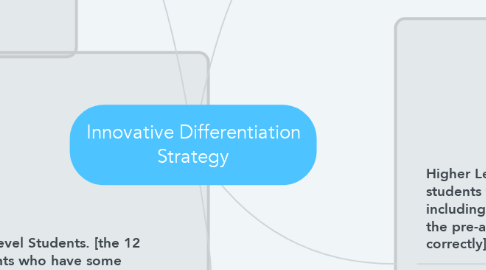Innovative Differentiation Strategy
by emily zien


1. Mid-Level Students. [the 12 students who have some knowledge about the topic as shown in their score, but need to develop higher order thinking skills]
1.1. One-Pagers & Peer-teaching: A One-Pager is a verbal and visual method for students to process and synthesize what they have learned about a topic (Potash, 2019). One-pagers follow the dual coding theory, that says the brain processes both verbally and visually (Potash, 2019). Students can use one page to respond to questions or prompts, do a “brain-dump”, and document their understanding through words, pictures, or a mind-map. Students within this group can then peer-teach by presenting their page to other students. Additional formative assessment can be included by way of self- or peer-assessment, using a simple rubric for students to reflect on their learning.
1.2. Reciprocal Teaching: Provides opportunity for students to practice or apply learning by way of this cooperative strategy. Gonzalez (2014) indicates that this strategy “will help students become more self-directed, increase academic gains, and improve the quality of social interactions.” Two students will work together, with Student A having the answers to Student B’s problems or questions, and Student B having the answers to Student A’s problems or questions. “Students take turns coaching each other through the problems, not giving the answers, but helping their partner reach the correct answer on their own” (Gonzalez, 2014).
2. Lower Level Students. [the 5 students who appear to have limited knowledge about the topic, of which 3 are struggling with language and are at different reading levels and 2 students who have little to no comprehension of the the topic and need to be tested further for special needs]
2.1. One-pagers: As described earlier, One-pagers provide a variety of ways for students to practice vocabulary words and to share their understanding both with images, quotations, or writing (Potash, 2019). The teacher can provide guidelines for what needs to be included, it can include having the students do additional research, and it can be a method for students to then report back and peer-teach.
2.2. Blended Learning stations provide this group of students access to additional content delivery, vocabulary practice, and direct teacher instruction, individualized to students’ specific learning needs. Online sites like Newsela allow teachers to select materials based on a student’s reading level. Teacher-led stations provide opportunity for the teacher to model problem-solving or processing through ‘Think-alouds’ or talk students with anxiety through the task (Gonzalez, 2016a).
3. Higher Level Students. [the 5 students who answered most, including the most difficult, of the pre-assessment questions correctly]
3.1. Playlists: an individualized digital assignment chart that shifts the responsibility of learning to the student, as they work through the plan at their own pace (Gonzalez, 2016b). Using a Google Doc, the chart provided students with instructions, a place to take notes, and a targeted timeline for completion. The Playlists can be differentiated for specific students, by revising or with the addition or subtraction of specific tasks.
3.2. Choice-Menus provide that the “teacher directs the menu process, but the student is given control over [their] choice of options, order of completion, etc,” (University of Virginia Curry School of Education, n.d.).
4. Blended Learning Stations
4.1. Online station
4.1.1. Newsela. BrainPop. Quizizz. Quizlet. Edpuzzle. Google Forms. Google Jam Boards. Videos with reflection questions or note-taking. Online research tasks.
4.2. Offline Station
4.2.1. Graphic organizers, One-Pagers, written tasks, problem-solving activity, peer-teaching with Jigsaw or Reciprocal Teaching. Gallery Walk, Chat-stations.
4.3. Teacher-led Station
4.3.1. Direct instruction. Formative Assessment. Active questioning. Conversations. Skills-practice. Modeling. Problem-solving.

